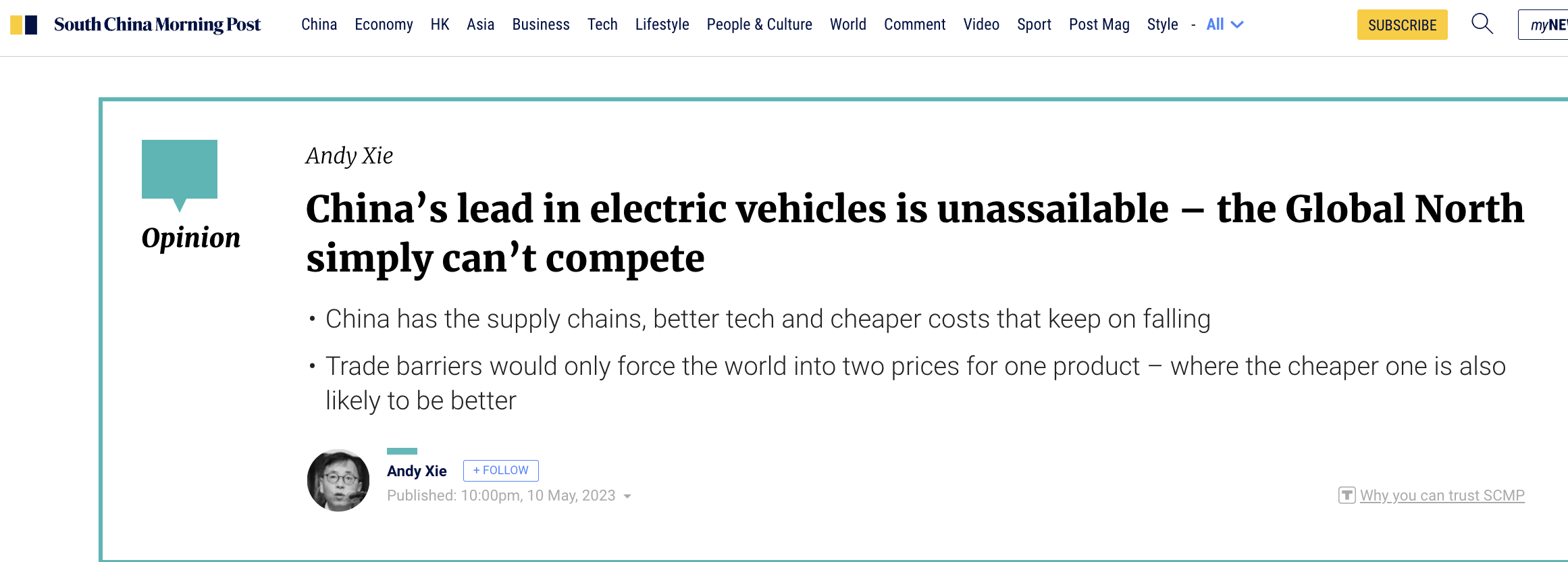Analyzing The Difficulties Faced By Western Automakers In The Chinese Market: A Focus On BMW And Porsche

Table of Contents
Intense Competition and Local Players
The Chinese automotive market is fiercely competitive, dominated by rapidly expanding local players. These domestic automakers, many of which are supported by substantial government investment, employ aggressive pricing strategies and are rapidly innovating, posing a significant threat to established Western brands. The rise of electric vehicles (EVs) further intensifies this competition. Chinese EV manufacturers like BYD, Nio, and Xpeng are gaining significant market share with technologically advanced vehicles and competitive price points.
- Rising popularity of domestic brands: BYD, in particular, has achieved remarkable success, consistently outperforming many Western counterparts in sales.
- Competitive pricing and innovative features of Chinese EVs: Local brands offer advanced features, often at a lower price point than comparable Western models.
- Government support for local automakers: Subsidies, tax breaks, and preferential treatment create an uneven playing field for foreign competitors. The push for domestic EV adoption also benefits local players disproportionately.
The prevalence of joint ventures further complicates the landscape. While initially intended to facilitate market entry, these partnerships often lead to technology sharing and potentially weaken the competitive position of Western automakers in the long run.
Navigating Regulatory Hurdles and Bureaucracy
Entering and operating in the Chinese automotive market involves navigating a labyrinthine regulatory environment. Import regulations and licensing procedures are notoriously complex, time-consuming, and expensive. Further challenges stem from stringent emission standards and safety regulations, demanding significant investment in adaptation and localization.
- Time-consuming and costly certification processes: Obtaining the necessary approvals can delay market entry and add considerable expense.
- Strict environmental regulations and the need for electric vehicle adaptation: China's commitment to reducing emissions necessitates significant investment in electric and hybrid vehicle technologies.
- Navigating the complexities of the Chinese legal framework: Understanding and complying with local laws and regulations requires significant legal expertise and resources.
These regulatory hurdles create significant barriers to entry and ongoing operational challenges for Western automakers.
Understanding and Adapting to Consumer Preferences
Chinese consumer preferences differ significantly from those in Western markets. While luxury brands remain highly desirable, Chinese consumers are also highly price-sensitive and prioritize value for money alongside advanced technology. Understanding and adapting to these nuanced preferences is critical for success.
- Emphasis on luxury brands, but with a preference for value and technology: Consumers expect high-quality, technologically advanced vehicles, but they also want competitive pricing.
- The importance of online sales and e-commerce platforms (Alibaba, JD.com): A robust online presence is essential for reaching Chinese consumers.
- Tailoring marketing strategies to resonate with Chinese consumer values: Marketing campaigns must consider the unique cultural context and values of the Chinese market.
Case Study: BMW's Challenges and Strategies
BMW faces intense competition from both local and other international brands. To counteract this, they have invested heavily in local production, allowing for better cost control and quicker adaptation to local preferences. Their marketing strategies focus on highlighting technological advancements and integrating with Chinese digital platforms.
Case Study: Porsche's Challenges and Strategies
Porsche's challenge lies in balancing brand exclusivity with the demands of a price-sensitive market. They are focusing on specific niche segments and actively promoting their electric vehicle offerings to appeal to the growing EV market in China. Maintaining brand image while adapting to local preferences is a key strategic focus.
Supply Chain Disruptions and Geopolitical Factors
Global supply chain disruptions and the ongoing US-China trade tensions significantly impact Western automakers operating in China. Securing reliable supply chains and managing logistics within the Chinese market presents a constant challenge.
- Impact of tariffs and trade restrictions on import costs: Trade disputes can lead to increased costs and uncertainty.
- Challenges related to sourcing components and managing production: Maintaining consistent production amidst global disruptions requires careful planning and diversification.
- Geopolitical risks affecting business operations in China: The complex geopolitical landscape introduces uncertainty and potential risks for foreign companies.
Conclusion
The difficulties faced by Western automakers in the Chinese market are multifaceted and require a sophisticated approach to overcome. From intense competition from domestic brands to navigating complex regulations and understanding evolving consumer preferences, success demands a deep understanding of this dynamic and challenging environment. For Western automakers aiming to succeed in the Chinese market, a deep understanding of these difficulties faced by Western automakers in the Chinese market is crucial for developing effective strategies for long-term growth and profitability. Further research and adaptation are essential for navigating this dynamic and competitive landscape.

Featured Posts
-
 John Wick 5 Diminishing Returns And Franchise Fatigue
May 11, 2025
John Wick 5 Diminishing Returns And Franchise Fatigue
May 11, 2025 -
 Undercover Footage New Allegations Surface Against Prince Andrew Regarding Underage Girl
May 11, 2025
Undercover Footage New Allegations Surface Against Prince Andrew Regarding Underage Girl
May 11, 2025 -
 Chicago Bulls And New York Knicks Whos In And Whos Out
May 11, 2025
Chicago Bulls And New York Knicks Whos In And Whos Out
May 11, 2025 -
 Marvels Cancellation Of Henry Cavill Show A Potential Upside
May 11, 2025
Marvels Cancellation Of Henry Cavill Show A Potential Upside
May 11, 2025 -
 Cooyahs Grand Slam A Deep Dive Into The New Track Collection
May 11, 2025
Cooyahs Grand Slam A Deep Dive Into The New Track Collection
May 11, 2025
